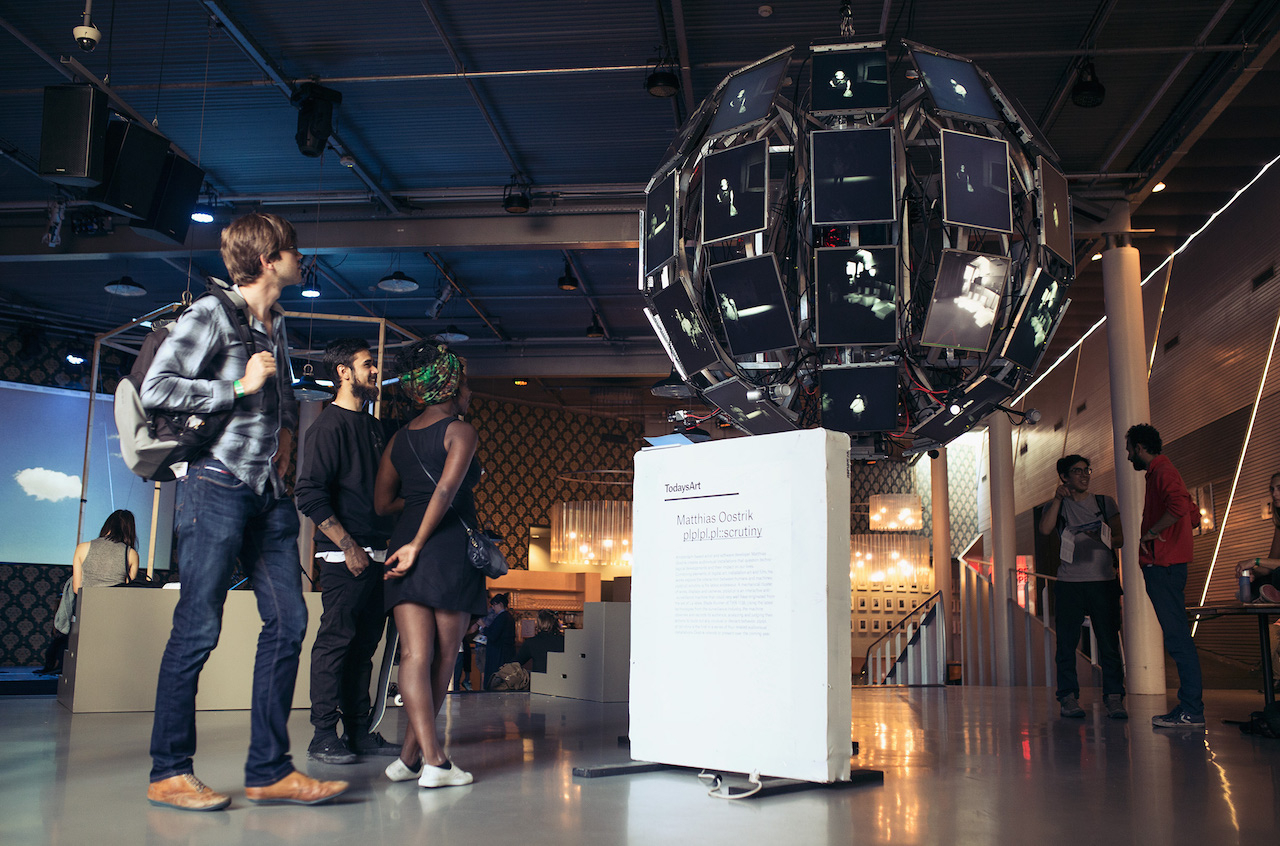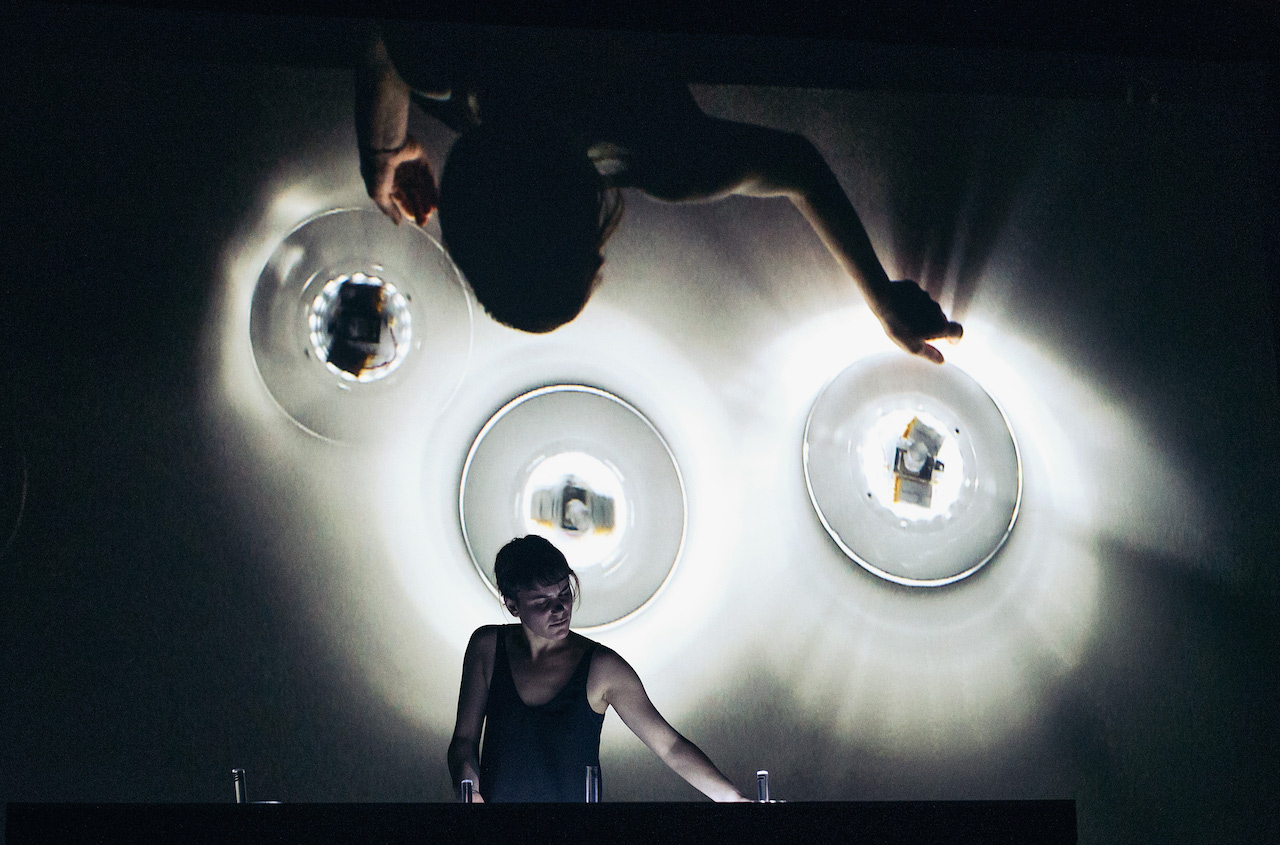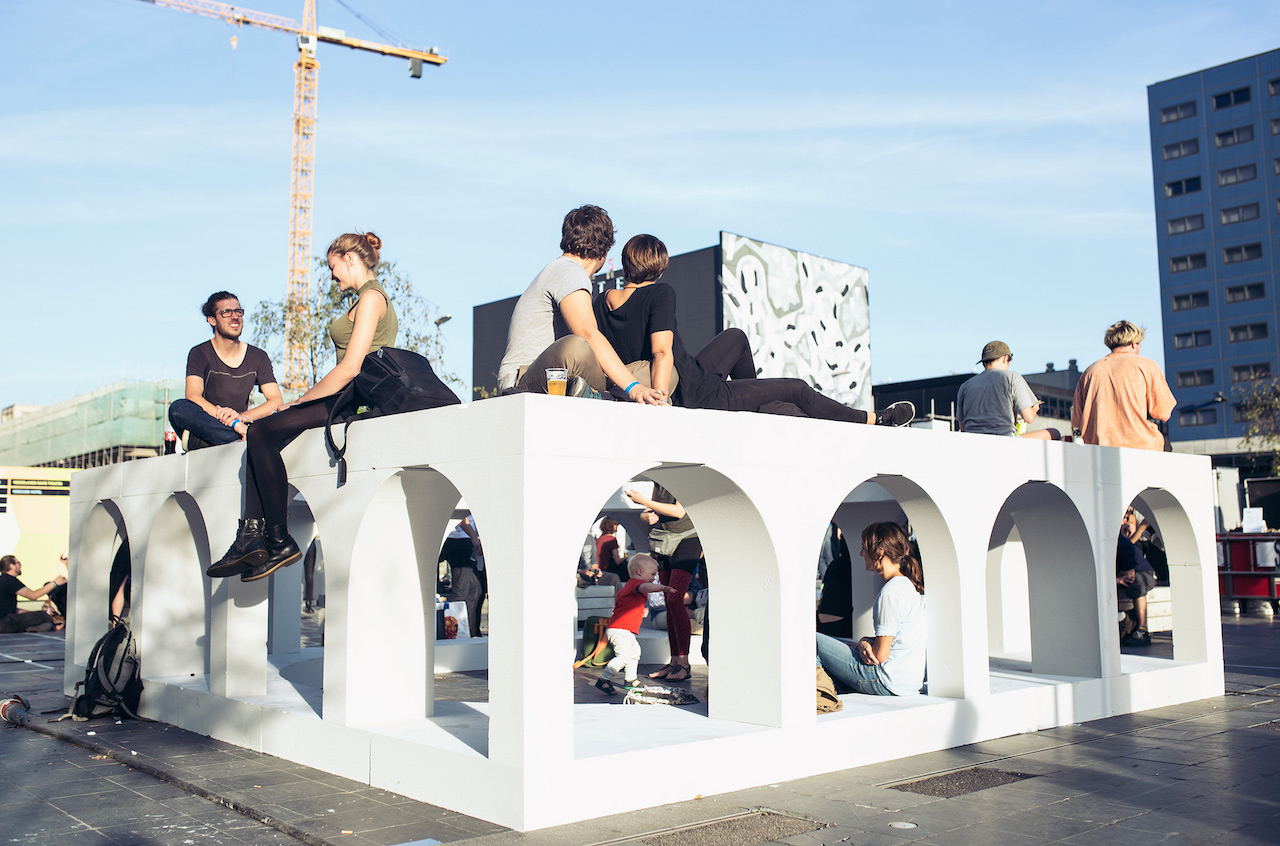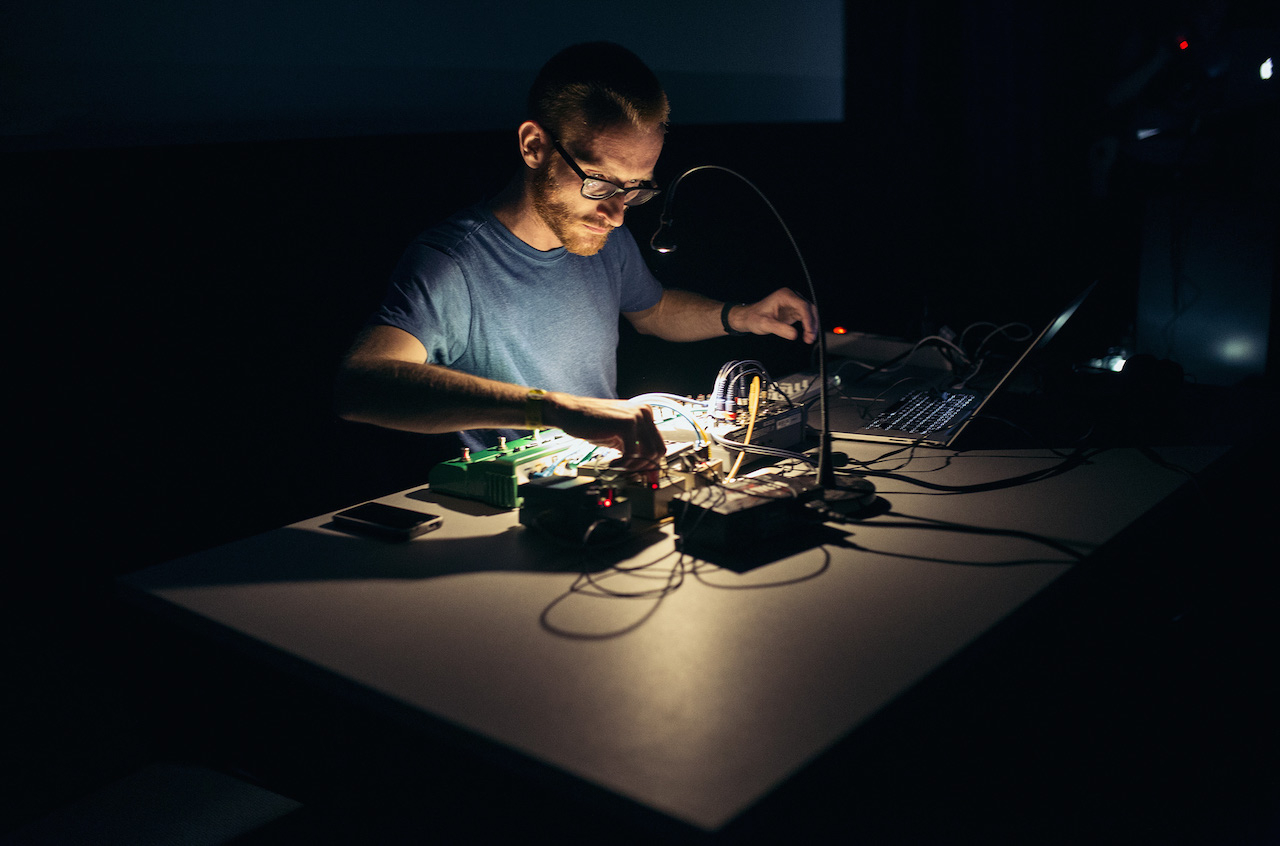- The last thing The Netherlands needs is another music festival, said TodaysArt director Olof Van Winden before the 12th edition of the music, technology and art festival began on Friday. Held in The Hague, the two-day event is modest in size (no more than 5,000 visitors per day) yet grand in ambitions. It aims to unite the academic world with emerging talents in the fields of liberal arts, music and technology by displaying hybrid art projects like Oscar, The Modular Body. The narrative and website created by Dutch filmmaker Floris Kaayk outlines the implications involved in 3D-printing organs from human cells. A demonstration of Kaayk's work was accompanied by a live score from Machinefabriek, a local artist who sat seated behind a table full of hardware. The crowd looked on with a mixture of fascination and fear, uttering oohs and ahhs upon seeing the battery-driven human sausage walk by itself on screen.
Similarly, Dopplereffekt managed to keep their audience engaged during a lecture on a topic that could easily have been too much for a Saturday evening: the Big Bang. Stardust, blobs and Milky Ways were projected onto a huge screen that dwarfed the speaker—cosmologist Dr. Dida Markovic—creating a starry universe all around her. While Markovic spoke, Dopplereffekt founder Gerald Donald (AKA Heinrich Mueller) manipulated a soundboard and various synths, at first to minimal effect. But as stardust collapsed into planets, the music started bubbling with energy. On its own the score wasn't that thrilling, but combined with telescopic images, it had the audience enthralled.
Another excellent hybrid piece was Soft Revolvers by Myriam Bleau. The Montreal-based artist connected four fluorescent spinning tops to a different bank of sample sounds (synths, beats, percussion and vocals), which she then triggered individually by grabbing the tops and spinning them round. While they lit up on the table in front, a screen behind her relayed real-time footage of the action. The resulting compositions—glitchy bass music with stuttering breakbeats, not unlike Oneothrix Point Never—sounded really cool.
It's multidisciplinary performances like these that earned TodaysArt the reputation as a forward-thinking platform. This year, the festival took over Spui Square or what is left of it—a giant gravel pit behind a wooden palisade. Architect firm ZUS designed polystyrene prototypes of Ancient Greek structures and scattered them around the square to challenge the use of public space in the political capital. At night, art school students, visitors and accidental passersby climbed the white blocks and sat on top of them, chatting and smoking spliffs. (I like to think they were discussing the ethics of democracy, but more likely it was the art of rolling joints.)
The Hague, known for its electro and techno, has always had a bustling underground. Festival director Van Winden was part of the close-knit squatter community that gave rise to labels such as Bunker Records and Crème Organization, and a certain punk aesthetic and DIY approach are still tangible in the theatre halls that house TodaysArt. On Friday, the foyer became the territory of experimental artist Limpe Fuchs and her self-built instruments—a giant drum made out of an oil container, a marimba carved from the front of a boat and flat granite stones. Fuchs, who drove her sonic tools all the way from Switzerland in the back of a pick-up truck, looked fierce as she threw stones at the granite keys and dragged copper strips around the floor. Eccentric performances like these can sometimes tip over into the absurd, but at least they provide a pleasant escape from your own regular music bubble.
TodaysArt silently rebels against the heavyweight-headliner virus by giving a platform to emerging talents that do not necessarily operate within a club context. Later on Friday, Japanese vibraphonist Masayoshi Fujita's warm melodic compositions soothed the audience into a state bordering on meditation. He covered his instrument with aluminium foil to mimic the sound of a rustling stream, letting the evening perfectly drift along. But Friday's highlight was Charlotte Bendiks, the latest addition to the Cómeme family. The Norwegian DJ started with Matias Aguayo's remix of Michael Mayer's "Lovefood," before working through tracks filled with Latin percussion that hit the hips hard. The likes of Ana Helder's "Nueva Ola, No Te Subas A La Cresta" and DJs Pareja's "No Dale Dale" urged people to take their shoes off and surrender completely to Bendik's body music.
On Saturday, most of the audience didn't make it as far as Paula Temple. The British techno artist closed the festival, coming on after Chicago's DJ Earl, who left mayhem in his wake. During Earl's set, two dancers—Sirr Tmo and Dre—raised one finger to the sky in honour of the late DJ Rashad, while the DJ paid homage to the footwork pioneer by opening with Rashad's "CCP2." The public, who stood huddled around the dancers in anticipation, were invited to join in. Keeping up with the dancers and their bouncing limbs was not easy, but by the end, everybody was getting involved. It was impossible not to—Earl's quickfire set of footwork edits, from Rihanna to Roy Ayers, was too infectious. After two days of challenging performances and thought-provoking installations, some no-frills partying was exactly what everyone needed.
Photo credit /
Raymond van Mil
 It's multidisciplinary performances like these that earned TodaysArt the reputation as a forward-thinking platform. This year, the festival took over Spui Square or what is left of it—a giant gravel pit behind a wooden palisade. Architect firm ZUS designed polystyrene prototypes of Ancient Greek structures and scattered them around the square to challenge the use of public space in the political capital. At night, art school students, visitors and accidental passersby climbed the white blocks and sat on top of them, chatting and smoking spliffs. (I like to think they were discussing the ethics of democracy, but more likely it was the art of rolling joints.)
It's multidisciplinary performances like these that earned TodaysArt the reputation as a forward-thinking platform. This year, the festival took over Spui Square or what is left of it—a giant gravel pit behind a wooden palisade. Architect firm ZUS designed polystyrene prototypes of Ancient Greek structures and scattered them around the square to challenge the use of public space in the political capital. At night, art school students, visitors and accidental passersby climbed the white blocks and sat on top of them, chatting and smoking spliffs. (I like to think they were discussing the ethics of democracy, but more likely it was the art of rolling joints.) The Hague, known for its electro and techno, has always had a bustling underground. Festival director Van Winden was part of the close-knit squatter community that gave rise to labels such as Bunker Records and Crème Organization, and a certain punk aesthetic and DIY approach are still tangible in the theatre halls that house TodaysArt. On Friday, the foyer became the territory of experimental artist Limpe Fuchs and her self-built instruments—a giant drum made out of an oil container, a marimba carved from the front of a boat and flat granite stones. Fuchs, who drove her sonic tools all the way from Switzerland in the back of a pick-up truck, looked fierce as she threw stones at the granite keys and dragged copper strips around the floor. Eccentric performances like these can sometimes tip over into the absurd, but at least they provide a pleasant escape from your own regular music bubble. TodaysArt silently rebels against the heavyweight-headliner virus by giving a platform to emerging talents that do not necessarily operate within a club context. Later on Friday, Japanese vibraphonist Masayoshi Fujita's warm melodic compositions soothed the audience into a state bordering on meditation. He covered his instrument with aluminium foil to mimic the sound of a rustling stream, letting the evening perfectly drift along. But Friday's highlight was Charlotte Bendiks, the latest addition to the Cómeme family. The Norwegian DJ started with Matias Aguayo's remix of Michael Mayer's "Lovefood," before working through tracks filled with Latin percussion that hit the hips hard. The likes of Ana Helder's "Nueva Ola, No Te Subas A La Cresta" and DJs Pareja's "No Dale Dale" urged people to take their shoes off and surrender completely to Bendik's body music.
The Hague, known for its electro and techno, has always had a bustling underground. Festival director Van Winden was part of the close-knit squatter community that gave rise to labels such as Bunker Records and Crème Organization, and a certain punk aesthetic and DIY approach are still tangible in the theatre halls that house TodaysArt. On Friday, the foyer became the territory of experimental artist Limpe Fuchs and her self-built instruments—a giant drum made out of an oil container, a marimba carved from the front of a boat and flat granite stones. Fuchs, who drove her sonic tools all the way from Switzerland in the back of a pick-up truck, looked fierce as she threw stones at the granite keys and dragged copper strips around the floor. Eccentric performances like these can sometimes tip over into the absurd, but at least they provide a pleasant escape from your own regular music bubble. TodaysArt silently rebels against the heavyweight-headliner virus by giving a platform to emerging talents that do not necessarily operate within a club context. Later on Friday, Japanese vibraphonist Masayoshi Fujita's warm melodic compositions soothed the audience into a state bordering on meditation. He covered his instrument with aluminium foil to mimic the sound of a rustling stream, letting the evening perfectly drift along. But Friday's highlight was Charlotte Bendiks, the latest addition to the Cómeme family. The Norwegian DJ started with Matias Aguayo's remix of Michael Mayer's "Lovefood," before working through tracks filled with Latin percussion that hit the hips hard. The likes of Ana Helder's "Nueva Ola, No Te Subas A La Cresta" and DJs Pareja's "No Dale Dale" urged people to take their shoes off and surrender completely to Bendik's body music. On Saturday, most of the audience didn't make it as far as Paula Temple. The British techno artist closed the festival, coming on after Chicago's DJ Earl, who left mayhem in his wake. During Earl's set, two dancers—Sirr Tmo and Dre—raised one finger to the sky in honour of the late DJ Rashad, while the DJ paid homage to the footwork pioneer by opening with Rashad's "CCP2." The public, who stood huddled around the dancers in anticipation, were invited to join in. Keeping up with the dancers and their bouncing limbs was not easy, but by the end, everybody was getting involved. It was impossible not to—Earl's quickfire set of footwork edits, from Rihanna to Roy Ayers, was too infectious. After two days of challenging performances and thought-provoking installations, some no-frills partying was exactly what everyone needed. Photo credit / Raymond van Mil
On Saturday, most of the audience didn't make it as far as Paula Temple. The British techno artist closed the festival, coming on after Chicago's DJ Earl, who left mayhem in his wake. During Earl's set, two dancers—Sirr Tmo and Dre—raised one finger to the sky in honour of the late DJ Rashad, while the DJ paid homage to the footwork pioneer by opening with Rashad's "CCP2." The public, who stood huddled around the dancers in anticipation, were invited to join in. Keeping up with the dancers and their bouncing limbs was not easy, but by the end, everybody was getting involved. It was impossible not to—Earl's quickfire set of footwork edits, from Rihanna to Roy Ayers, was too infectious. After two days of challenging performances and thought-provoking installations, some no-frills partying was exactly what everyone needed. Photo credit / Raymond van Mil